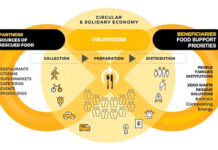Changing the way fisheries are quantified from tonnage to the number of individuals caught in the wild will make fishing more sustainable and protect fish welfare. This is the aim of the study ‘Estimating global numbers of fishes caught from the wild annually from 2000 to 2019’ (A. Mood and P. Brooke, 2024) published in Animal Welfare. (1)
1) The contradictions of fishing
Deep-sea fishing is very important for the livelihood of millions of people around the world. More than 3 billion people depend on fish for at least 20% of their animal protein intake. The percentage rises in developing countries, where fish protein accounts for 50% of requirements. (2)
The abuse of fish stocks, also encouraged by fishing incentives, has resulted in 90% of fish stocks being exploited, overexploited or depleted. Suffering the consequences are the poorest populations dependent on small-scale fishing, who have their fish resources taken away from them by richer countries. With the aggravating factor that most of this fish does not reach our tables but, as we shall see, becomes feed for farmed fish.
2) The lack of fishing numbers
Unlike birds and mammals bred for human consumption, of fish caught and farmed we only have weight estimates. Yet fish account for 87.5% of vertebrates killed for consumption in 2019. The lack of the number of individuals caught does not allow us to fully understand the problem of overfishing and animal welfare that is not applied to capture fisheries.
Researchers A. Mood and P. Brooke (2024), therefore, for the first time attempted to estimate the number of fish caught in the wild. To do this, they used estimates produced by the FAO in terms of tonnes of fish caught and cross-referenced them with the average weight of fish of various species at the time of capture. The results were published in the study ‘Estimating global numbers of fishes caught from the wild annually from 2000 to 2019’.
2.1) Estimated fish caught
According to FAO data, an average of 77.3 million tonnes of fish were caught per year from 2000 to 2019, belonging to 1725 different species. For 62% of these species, it was possible to identify the average weight of fish caught (EMW), and cross-referencing the data reported a corresponding number between 720 and 1500 billion fish. For the remaining fish categories (38%), general average weights (GEMW) were used and the result yielded 340-690 billion fish. (3)
Between 2000 and 2019, an average of 1100 to 2200 billion fish per year were estimated to be caught at sea. In 2019 alone, 980-1900 billion were caught, to which 78-171 billion of farmed fish should be added, compared to 81 billion of birds and mammals bred for human consumption.
The anchovy is the most fished species in terms of individuals, with an average of 6.7 million tonnes per year. In terms of weight, however, the most fished category is that defined as ‘Nei’ or ‘not included elsewhere’.
88% of fish are caught in the marine environment while 12% are caught in inland waters. The main catching environments are the Pacific Ocean and the Atlantic Ocean where together 75% of the catches took place. At the level of continents, Asia and the Americas account for 76% of fish caught. Finally, by country, Peru, China, the EU-27 and Chile together account for almost half of the global estimated catch.
2.2 The numbers excluded from the estimates
These estimates are to be considered downwards as they do not take into account, due to lack of data, illegal, unreported or unregulated fishing and fish caught and thrown back into the water.
In a previous study, Pauly & Zeller (2016) used various sources to start a ‘catch reconstruction’ process. They estimated that for the year 2010, total catches of marine fish and invertebrates (excluding corals and sponges) included 32 million tonnes more than those reported by FAO.
According to FAO, on the other hand, discards of animals (excluding corals and sponges) globally amounted to 9.1 million tonnes per year from 2010-2014. According to data published by the Sea Around Us website and taken from the Pauly et al. (2020) study, global discards and unreported landings in 2019 amounted to 8.4 million tonnes and 16.1 million tonnes, respectively.
3) The huge numbers destined for feed
The greatest paradox of fishing is that more than half of the fish caught in the wild is used as feed for farmed fish. According to 2010 estimates, about 490-1100 billion fish out of 1000-1900 billion total fish caught were processed into fish oil and fishmeal. This corresponds to 56% of the total fish caught, with an average weight of 15-33 g.
70% of fishmeal and 73% of fish oil are used to feed farmed fish and crustaceans. These are mainly small fish, such as anchovies, which play a key role in the seas. They are indeed at the base of the marine food chain, but the high draught is undermining the survival of their shoals, threatening the balance of the seas and the livelihoods of the poorest people who live from fishing.
4) Wild fish, where’s the animal welfare?
There is evidence that fish are also capable of experiencing pain and of changing their motivational state following painful events. The question of the animal welfare of fish caught in the wild should therefore be asked. And since animal welfare also depends on the number of individuals subjected to the stress factors, as well as the extent and duration, given the number of fish caught, the question becomes enormous.
Fish caught in the wild experience various stress factors. Those that are still alive when recovered on board are generally not stunned and die by evisceration and/or asphyxiation in air or ice water. In such cases, the loss of consciousness may last up to one or more hours.
4.1) Countries with welfare requirements for fish
There are no welfare regulations for fish caught in the wild. There is protection for freshwater and inland fisheries in Switzerland. Other welfare requirements exist in New Zealand, for fish caught for later killing, e.g. in restaurants.
In many countries, which together account for 64% of wild caught fish, there is an obligation to protect the welfare of aquaculture fish during slaughter. This should, logically, also be guaranteed for wild fish.
5) Conclusions
Knowing the number of fish that are caught in the wild each year would also help us to recognise fish as individual wild animals and not just as commodities. Animals capable of feeling pain and in need of protection through conservation and animal welfare measures.
Trends in fish populations could be monitored, how they vary over time, and how fishing affects reproductive capacity. According to FAO, 35.4 per cent of fish stocks fished in 2019 were of biologically unsustainable levels.
Consuming smaller fish, downstream in the marine food chain, is beneficial for nutrition, food security and the environment. This would, however, increase the number of fish caught, which is already unsustainable. Unless this type of fish is diverted to other uses, such as processing into feed for farmed fish, which, as we have seen, takes up more than half of the catch. One possibility to curb this problem would be to choose to breed smaller species of fish to be fed on fish and seaweed waste feed. (4) As well as reducing our fish consumption. (5)
Alessandra Mei
Cover image from Pixabay
Footnotes
(1) Alison Mood & Phil Brooke (2024). Estimating global numbers of fishes caught from the wild annually from 2000 to 2019. Animal Welfare. 2024. 33:e6. Doi: https://doi.org/10.1017/awf.2024.7
(2) D.F. Viana, J. Zamborain-Mason, S.D. Gaines, et al. Nutrient supply from marine small-scale fisheries. Sci Rep 13, 11357 (2023). https://doi.org/10.1038/s41598-023-37338-z
(3) EMWs (estimated mean weights) are the average weights of fish obtained by combining FAO catch production tonnages with data on average weights of fish caught published on the Internet. Generic estimated mean weights (GEMWs) are the generic estimated mean weights of fish and were used for species categories for which EMWs were not available.
(4) Dario Dongo, Alessandra Mei. Aquaculture, reduction and upcycling of fish waste into protein, Omega-3 and micronutrients. GIFT (Great Italian Food Trade). 20.6.2023
(5) Dario Dongo, Andrea Adelmo Della Penna. Alt Fish, the vegetable alternatives to fish products. Food Times. 17.9.2021
Graduated in Law from the University of Bologna, she attended the Master in Food Law at the same University. You participate in the WIISE srl benefit team by dedicating yourself to European and international research and innovation projects.








